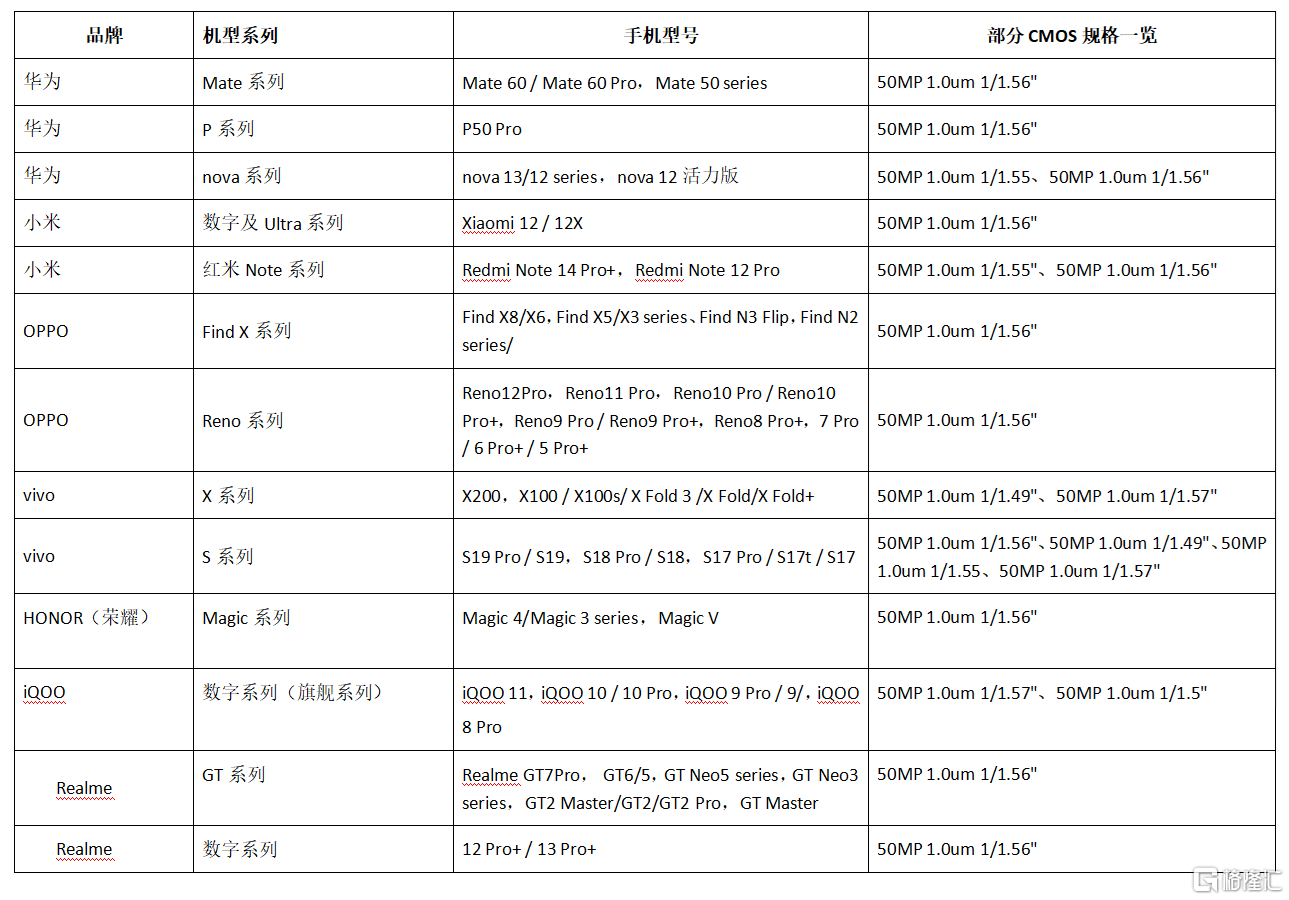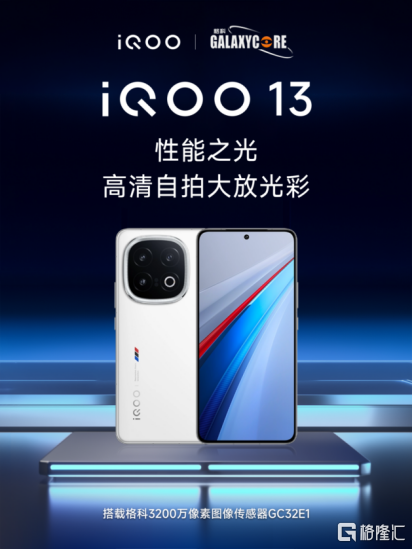Recently, the CIS leader Geke Micro announced that the company won the 2024 Global Electronics Achievement Awards (WEAA) hosted by AspenCore, the world's leading technology media organization in the field of electronic engineering, and its 1.0μm 50 million pixel product GC50B2 won the Sensor Product of the Year Award. Since the end of 23, Geke Micro announced two 50 million pixel products GC50E0 and GC50B2, investors once again saw GC50B2 in the company's public news.
Image sensor of the year GC50B2
Previously, the company had announced that its 50 million pixel products had achieved mass production for brand customers. If GC50E0 is Gekewei's initial attempt to the mid-to-high-end main camera market, then the large-size pixel product GC50B2 developed by Gekewei based on high-pixel single-chip integration technology is a bright sword that directly refers to the main camera of mid-to-high-end brand mobile phones.
According to Geke Micro's public information, GC50B2 is its first 1.0μm 50 million pixel image sensor, using 1/1.56 optical size, through the innovative design of pixel technology and circuit architecture, it can achieve high pixels and high performance, providing excellent color reproduction performance and excellent image resolution. The product is also equipped with Geke's self-developed DAG (Dual Analog Gain) HDR single-frame high dynamic technology, which improves the dynamic range through the innovative design of the circuit, and can output up to 12bit image data, so that the mobile phone can preview, take photos and videos, and output high dynamic images with rich light and dark details and accurate colors at lower power consumption.
Figure: A mainstream model equipped with a 50-million-pixel CMOS with a pixel size of 1.0 μm

Source: official websites and official accounts of various brands, media platforms such as Sina and NetEase, Adicotton mainstream mobile phone image sensor ladder, China Post Securities
The GC50B2 is suitable for the main camera of many mid-to-high-end phones. By collecting and collating the CMOS parameter data of each model, we found the following key points:
1. Judging from the models released in recent years, 50MP is still the mainstream: although in the past few years, there have been assertions that 64MP, 108MP and even 200MP will replace 50MP, but this is not the case. Even the more expensive flagship and high-end models are not blindly chasing higher pixel values. Currently, the level of around 50 million pixels is still the most widely adopted option. The reason for this is that while higher-pixel image sensors offer significant technical advantages, they face greater challenges in terms of production costs, power consumption, heat dissipation, and image processing algorithms, which limit their adoption in certain application scenarios. In contrast, the 50MP image sensor shows comprehensive advantages in terms of cost performance, user experience, and technology maturity.
2. The pixel size is concentrated at 1.0μm: The pixel size of the 50 million pixel CMOS image sensor is mainly concentrated at 1.0μm, and there are also 1.2μm and 1.6μm options. Among them, the 1.0μm pixel size has become the mainstream choice due to its balance between imaging effect, size, and cost. Under the current technical conditions, 50MP combined with 1.0μm pixel size is the optimal solution under the "imaging effect, size, cost" scheme. For example, the latest addition to Huawei's highest-end model, the Mate 60 Pro, still uses a 50MP, 1.0μm CMOS.
3. "50MP, 1.0μm" has become the standard configuration of the new machine and has become a future trend: among the main models of various brands newly released this year, the configuration of "50MP, 1.0μm" is widely adopted. In particular, in the fourth quarter, new machines were released intensively, and the CMOS chips used in these new machines are enough to illustrate the future development trend. For example, Huawei's mid-to-high-end nova 13 series (launched in October 2024) uses a "50MP, 1.0μm" CMOS chip. In addition, the Redmi Note 14 Pro+ (released in September 2024), Find X8 series (released in October 2024), Reno12 Pro (released in May 2024), X200 series (released in October 2024), S19 Pro/S19 (officially available in May 2024), Magic 7 series (released in October 2024), and the upcoming Realme GT7 Pro and Realme 13 Pro and other models (according to some media bloggers' speculation), also use this configuration.
4. Some series models are also returning to 50MP 1.0μm: some models have returned to this configuration in new products after switching from 50MP 1.0μm to other configurations in several generations. For example, the Find X6 uses a 50MP 1.0μm CMOS, while the X7 uses a different configuration, but the just-released X8 returns to 50MP 1.0μm. A similar situation has occurred with series such as Redmi. This shows that 50MP 1.0μm is likely to remain the "sweet parameter" of CMOS in the future, and most of the mainstream new products of major brands are adopting this configuration, which corresponds to the broad market demand.
From the sales data of some models, we can get a glimpse of the market potential corresponding to GC50B2. The sales volume of the Huawei nova 13 series equipped with 50MP and 1.0μm exceeded 110,000 units on the first day of sales, setting a new record for the first sale of 2000-4000 yuan in 2024, and the global sales of the nova series exceeded 190 million units. The national sales of the Redmi Note13 series also reached 3.2 million units; The cumulative sales of the vivo X100 series on the first day of sales reached 1 billion yuan. Obviously, GC50B2 is facing a market with tens of millions or even hundreds of millions of mobile phone sales.
Referring to the company's previous rhythm of mass production and terminal application of single-chip 32 million pixel products, Geke Micro's 1.0μm 50 million pixel products will become one of the most competitive choices in the CIS market for the rear main camera of mid-to-high-end brand mobile phones, opening up a new growth space for the future development of Geke Micro.
Single-chip 32 million pixel products continue to be recognized by mainstream models
In addition to the latest 50 million pixel product related news, it is also worth noting that Geke Micro recently announced that its single-chip 32 million pixel product GC32E1 has been successfully installed in the front camera of IQOO 13. As the flagship of the IQOO brand, IQOO 13 chose GC32E1 as its front camera, which is undoubtedly a high recognition of Gekewei's high-pixel single-chip integration technology and product strength, proving that Gekowei can meet the stringent performance requirements of mainstream Android brand mobile phone flagship models.
Combined with the company's previously released 32 million pixel product application dynamics, it can be clearly seen that since the third quarter of last year, the company's products have achieved significant jumps in two major aspects.
On the one hand, it is a comprehensive upgrade of the application model. From the early stage of mass production to today's wide application, Geke micro-chip 32 million pixel products have successfully entered vivo Y300 Pro, OPPO A3x, OPPO Reno12 overseas version and iQOO 13 and other popular models. It is worth mentioning that the quarterly mobile phone tracking report released by IDC shows that in the second quarter of 2024, the Reno 12 series will help OPPO top the list in the market share of 2000-3000 yuan; The A3 Pro became one of the best-selling products in the 1000-2000 RMB market. The vivo Y300 Pro sold five times as much on the first day of sale, setting a new record for the Y series. Released in October 2024, the iQOO 13 is the latest addition to the iQOO digital series, breaking the all-time sales record on the first day of launch, surpassing the sales volume of the iQOO 12 series in the first 30 minutes, and the overall sales on the first day of sales have set a new sales record for all new phones in iQOO's history.

The core products and blockbuster products of these domestic mobile phone brands have chosen Gekewei's single-chip high-pixel products, which not only highlights the brand's recognition and support for the company's technology and products, but also reflects the cooperation attitude of each brand to put Gekewei's products in a strategic position. This strategic cooperation will bring a long-term win-win situation for both parties.
On the other hand, the rapid upgrading of product generations has verified the great success of the single-chip high-pixel technology platform. Since the successful development and release of the world's first single-chip 32-million-pixel CMOS image sensor GC32E1 in 2022, the company announced the successful mass production in Q3 of the following year, and in December 2023, the company launched two single-chip 50-million-pixel CMOS image sensors GC50B2 and GC50E0 for the first time, and announced the successful mass production of the high-performance second-generation single-chip 32-million-pixel image sensor GC32E2 in mid-24. In October 2024, it was announced that the 50 million pixel product will be mass-produced and shipped. The rapid pace of product iteration and commercialization fully demonstrates the company's innovative R&D capabilities.
At the recent performance exchange meeting, the company said that it expects to continue to optimize old products and launch new products from the end of this year. The new products will use the company's second-generation technology, and have made great progress in performance, which is not inferior to the well-known products of the same specification on the market. It is foreseeable that the company will quickly achieve iterations of 32 million and 50 million pixel products and complete a breakthrough in performance.
Since Geke Micro embarked on a completely different technical path from the stacking architecture represented by overseas manufacturers, its high-pixel single-chip integration technology and products have appeared in the market after every announcement. Some people believe that since overseas industry giants have failed to achieve this goal, how can Gekewei easily succeed? Some voices pointed out that single-chip technology is not the current mainstream direction and is difficult to be widely accepted by the market.
However, in the face of these doubts and challenges, Gekewei has always maintained a steady pace of development, constantly overcome technical difficulties, and gradually won the trust and recognition of customers. With its unique Fab-lite business model, independent research and development of core technology, controllable production capacity and rapid research and development capabilities, the company has successfully embarked on a technical route with Geke micro characteristics.
With the full cooperation and support of brand customers, as well as the continuous iteration and upgrading of the company's own technology, Gekewei's single-chip 50 million pixel products will be like 32 million pixel products, quickly realizing the wide coverage of product application models and the rapid leap between generations. The company is expected to achieve an effective replacement of traditional stacked products in various price ranges, so as to open up a development path of its own for Chinese CIS manufacturers, challenge the market position of international friends, and strive to become a global leader in the field of CIS.
Ticker Name
Percentage Change
Inclusion Date